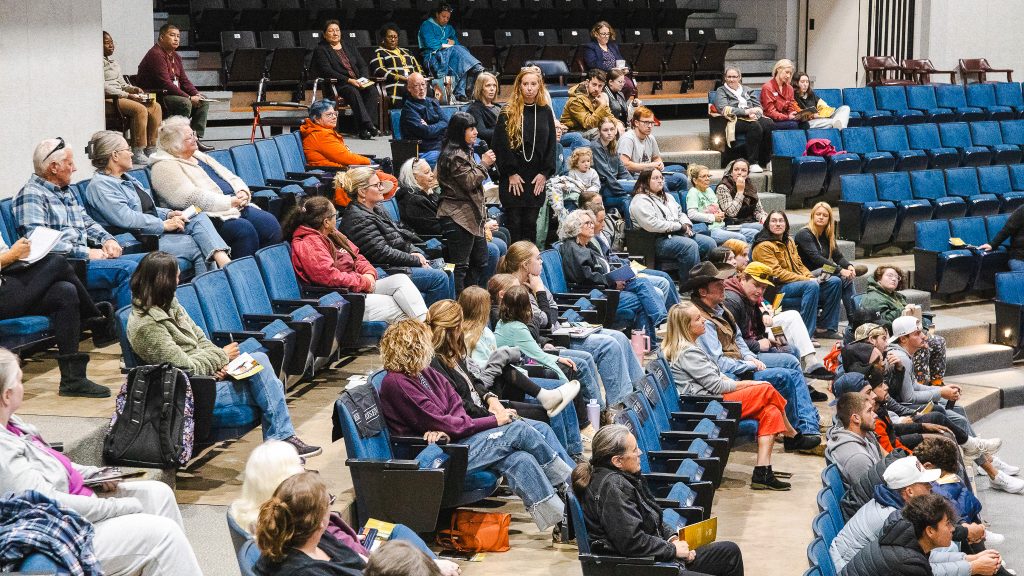On Nov. 10, students, faculty and community members filled the Jeff Johnston Auditorium at Seminole State College for “An Afternoon with Temple Grandin.” The renowned animal behaviorist and advocate for neurodiversity appeared via Zoom, presenting “Animal Welfare Presented Through the Lens of Autism,” a talk that braided the two themes that have defined her career: humane livestock handling and opening doors for visual and hands-on thinkers. The event was made possible by SSC’s Native American Serving Non-Tribal Institutions federal grant program, which is funded in the amount of $450,000 annually.

Grandin has spent five decades turning a different way of seeing into a different way of solving problems. A distinguished professor of animal science at Colorado State University for more than 30 years, she earned a bachelor’s degree in psychology from Franklin Pierce, a master’s in animal science from Arizona State University and a doctorate in animal science from the University of Illinois. Diagnosed with autism, she has written extensively about how sensory differences and visual thinking shaped her approach to problem-solving — insights that have guided both her scholarship and her teaching.
That perspective started with chores rather than charts.
“So basically it was exposure to cattle as a teenager,” Grandin said in a phone interview before the event. “My boarding school had a small dairy. I learned to milk cows there. And then when I was 15, I had a chance to go out to my aunt’s ranch in Arizona. That got me exposed to the beef industry. I can’t emphasize how important it is for students to get exposed to different things in order to get interested in them.”
Her most visible impact is in stockyards and processing plants. Close observation of animal behavior led her to design curved chutes, make lighting adjustments and champion low-stress handling practices that reduce fear and injuries in cattle and pigs. The habit of seeing what animals see crystallized in graduate school.
“The first thing I did when I got out to the feed yards in Arizona was to get in the chutes and see what the cattle were seeing,” she said. “I noticed that they would stop at shadows and water puddles and a piece of rope or something hanging down. At the time, I did not know that I was a visual thinker. I just assumed that everybody was a visual thinker.”
The field lessons weren’t all triumphs. Grandin is quick to point to a failure that taught her to chase root causes instead of symptoms. In the 1980s, she designed a conveyor to help pigs reach an upper floor at a processing plant. “It was a failure,” she said. “And this thing failed and it flipped the pigs over backwards. It was a real mess. And one of the things I learned from that is you have to treat root causes of problems. Only certain pigs were not capable of walking up the big ramp. They had a genetic problem called spraddle leg. You need to treat root causes of problems, not symptoms of problems.”
That insistence on root causes maps directly onto her classroom message: the world needs all kinds of minds, and colleges should provide multiple on-ramps to mastery. In her 2022 book, “Visual Thinking: The Hidden Gifts of People Who Think in Pictures, Patterns, and Abstractions,” she calls for bringing back robust shop classes, lab-rich coursework and project-based assessment so students can demonstrate skill, not just test-taking. “I think one of the worst things the schools have done is taking all the practical classes out,” she said. “I’d put those classes back in. Sewing, cooking, shop.”
For educators, the implication is straightforward: design courses where abstractions are anchored to things students can see and touch. That might mean demonstrations, field trips, labs and internships that give novices the language of the trade and the confidence of repetition.
Grandin links these practical steps to a broader talent strategy. “We actually have a huge shortage of people in skilled trades,” she said, noting employers who need mechanics with strong mechanical aptitude. She has known welders and machinists who “could build anything,” including even if they didn’t understand algebra. The people who thrive in those shops are often the same ones who struggled with timed tests. “I like to see them get out in the trades. They’re going to have a job,” she said. “I was one of those students. I failed the SAT in math and just got a mediocre score in the verbal. And I get very nervous during tests. But some of these are ones that will excel in hands-on things.”
Research in higher education backs up pieces of Grandin’s case. Lab-rich instruction and project-based learning can increase persistence, particularly for first-generation students and those from underrepresented groups in STEM. Portfolios and internships regularly show up in employer surveys as better predictors of early-career success than standardized test scores.
Her visibility outside the classroom remains high. Time magazine named her to its list of the 100 most influential people in 2010, and HBO’s “Temple Grandin,” starring Claire Danes, introduced her story to a global audience.
“It didn’t change teaching or research that much, but it sure changed my travel schedule,” she said. A new documentary, “An Open Door,” focusing on her teaching and recent work, released earlier this year.
Back in the Jeff Johnston Auditorium, even through a screen, her call was unmistakable: build on-ramps for all kinds of thinkers. Tie math to machines, theory to tools and assessment to the work itself. For students imagining careers in animal science, pre-veterinary studies, biology, engineering technology or the skilled trades, Grandin’s trajectory is a blueprint for turning curiosity into a career. And for educators, the assignment is clear: make room in the syllabus, the lab and the plant for the kinds of minds that see the world differently and therefore change it.